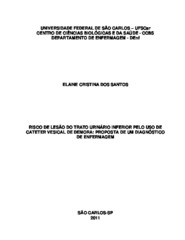Risco de lesão do trato urinário inferior pelo uso de cateter vesical de demora: proposta de um diagnóstico de enfermagem

Visualizar/
Data
2011-02-17Autor
Santos, Elaine Cristina dos
Metadata
Mostrar registro completoResumo
Vesical catheterization is one of the most frequently performed invasive interventions in the hospital and its indications are of fundamental importance for the patients that need it. Their insertion, maintenance and withdrawal are under responsibility of nursing team. However, the use of an indwelling catheter can result in complications. In this context, nursing plays a critical role, since most of the complications are likely to be prevented through specific interventions. This study aimed to identify the evidences available in the literature on the risks of injury to the low urinary tract due the use of indwelling catheters and to examine how the risk of injury by the use of indwelling catheters can be approached through the Nursing Diagnosis of the North American Nursing Diagnosis Association - International (NANDA-I). From an integrative literature review, 32 studies were included, 22 were selected from PubMed, 4 in LILACS, 3 in The Cochrane Library and 3 in CINAHL. The predominant studies identified were case studies and actualizations. About the year of publication, 46.9% were published in the interval from 2000 to 2009. About the main investigator 62.5% were physicians ant it was noted a predominance of articles published in journals of urology. Complications identified were grouped into three categories: injuries, complications secondary to injuries and others. From this identification, the factors that contribute to the development of lesions were identified making it possible to perform a fundamental analysis for the identification of risk factors for low urinary tract injury due the use of indwelling catheters. The results revealed an absence in NANDA-I of a nursing diagnosis that portray the human response on the vulnerability of people undergoing the use of indwelling catheters, and it was suggested, based on Scroggins (2010), that a new nursing diagnosis, Risk of injury to the lower urinary tract can be considered to inclusion as a nursing diagnosis. It is expected that the recognition of risk factors relating to this type of injury can contribute to increase the effectiveness in the development of nursing care plans.